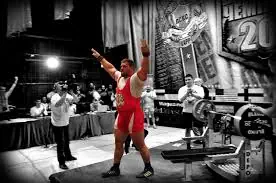Olkaa hyvä, Voimaharjoittelu.fi tarjoaa ylpeänä artikkelisarjan voimaharjoittelun huipulta.
Kyseinen artikkeli on osa Louie Simmonsin kirjaa Westside Barbell Book of Methods. Yli 230 sivuinen kirja käsittelee kaikkea voimailuun liittyvää Louien ainutlaatuisella käytännön ja tieteen yhdistävällä tavalla.
TRAINING METHODS by Louie Simmons, osa III
There is much talk about training philosophies, methods, and methodologies. It seems everyone
has their own, which they devised on the basis of their own experience. They recommend such
strategies as doing reps to failure to eliminate assistance work and doing only the squat, bench
press, and deadlift. Have you ever wondered what the author has accomplished as a lifter, a
trainer, or a scientist? Did they ever total Elite or fi eld a team of Elites at a national meet? Did
they ever make a top ten lift in one or more categories? Or is what they are doing a personal
philosophy with no proven results?
It has been asked what philosophy Westside adheres to. The answer is none. We use training
methodologies and the science of methods. Everything we do is based on a scientifi c principle.
We can not be so arrogant as to form a personal philosophy. At Westside, we are responsible
not only for our own training but for the training of our loyal readers. Many of our “extended
members” have become national, world, and European champions.
Training is not as simple as doing fi ve sets of fi ve reps, fi ve sets of ten reps, or any
combination of sets and reps. You must plan to obtain certain objectives. Increases in speed,
explosive strength, absolute strength, and stamina are equally important. It has been known and
discussed in Weightlifting for All Sports by Ajan and Baroga that a greater training result can be
obtained over a greater length of time by using special exercises than by doing the classical lifts.
Doing the same exercises repeatedly will rapidly decrease your coordination. There are many
reasons for this. Our observation is that very few lifters can increase their abilities without special
exercises.
How do we train heavy continuously? The answer is to pick several special barbell exercises
for a particular lift (e.g. the deadlift). The good morning is very similar in motion to deadlifting.
A conventional deadlifter will no doubt bend over. Therefore, bent over good mornings will
increase the deadlift. But remember, when doing the good morning, you must duplicate the action
of your deadlift precisely in your brain. It is not so important to raise your good morning as it is
to raise your deadlift by performing the good morning. We do many types of good mornings such
as one with a safety squat bar suspended from chains. Remember to use the same body mechanics
as you do in the deadlift.
Repeated Effort Method
I have previously discussed the different methods of training that are utilized at Westside. The
dynamic method replaces a maximal effort day and builds explosiveness and speed-strength. The
maximal effort method builds strength-speed and absolute strength.
We know that training with weights above 90% for three weeks will cause a negative training
effect. To remedy this, the conjugate method is employed. Each week on maximal effort day we
use a different core exercise and max out with 100% or more. It can be a good morning, pull, or
special squat for the squat and deadlift or a fl oor press or board press for the bench press. If you
think about it, Strongman events are really the conjugate method. It’s not uncommon for a top
Strongman to deadlift 800 or more.
Many don’t realize it, but we also use the repetition method to failure, though never in the
classical lifts. Rather, we do special exercises with dumbbells, belt squats, the reverse hyper, and
so forth. I prefer to do repetitions for time in a slow tempo and don’t bother to count reps.
If this sounds new to you, it’s not. In the 1970s, the great Olympic lifter, Vasili Alexeyev, used
a variation of the repetition method for part of his training. He sometimes did power cleans nonstop
for 2–3 minutes. He did various hybrid exercises like the front squat, push press, squats with
the bar on his back, and drop squats. The bar weight was light but would work every muscle cell.
He did a warm up by throwing a 220-lb barbell over his head backward 100 times. Then after
practicing the snatch for over two hours, he spent an hour in the pool, lifting his legs hundreds of
times to strengthen his abdomen. He leaped nearly 1000 times and used many exercises to gain
great strength in order to raise his work capacity and, of course, his total. This is precisely what
Westside is after.
Here are some examples of how the repetition method is used at Westside:
1. For the squat or deadlift, I will do belt squats for 3– 4 sets of three minute sets, 2–3 sets of
abs, or the reverse hyper for 1–3 sets of 1–3 minutes each.
2. Another workout consists of band good mornings with a single set sometimes lasting
6–8 minutes depending on band tension. Follow this with light dumbbell presses for 2–4
minutes nonstop.
3. Walk with a sled for up to fi ve minutes with light resistance. Follow with abdominal work.
4. Do light deadlifts for 1–3 minutes followed by abdominal work for at least two minutes.
5. Pick up a barbell and throw it overhead behind you or do the same exercise with medicine
balls. This works the entire body. After throwing it, simply walk over to it and do another
rep.
6. Do band leg curls for 3–6 minutes followed immediately by band leg extensions.
7. Perform dumbbell power cleans for 1–3 minutes either holding them at your waist, on
your shoulders, or, of course, over your head.
8. Do dumbbell pressing on a bench or (my preference) on a stability ball. I use three
different weights depending on the day. After the dynamic workout, I use 100s for three
minutes. On max effort day, I have done 75s for fi ve minutes. Four or fi ve times a week, I
use 40s for a set of 3–10 minutes.
Using weights of roughly 20–30% will serve as restoration because they’re not heavy enough
to stop adequate circulation via strong muscle contraction. To validate some of the fi ndings
at Westside, high reps with very light weight are stated as being benefi cial in the rep range of
100–200 in Science of Sports Training by Thomas Kurz. Olympic long jumper, Diane Guthrie,
had been doing 250 leg curls every day using 10-lb ankle weights. She noted that when she
slacked off the work, she incurred leg injuries. People make a mistake thinking that there is only one method of training. In fact, there are many, and they must coexist in a continuous chain of proven methods. When doing the
workouts I have outlined, remember to do them with a slow tempo. This means 6–10 reps per
minute, resting between reps while still holding onto the bar or dumbbell. Regardless of where
you hold the bar or dumbbell, it will work the muscles to their fullest extent.
A great benefi t of the repetition method is an increase not only in all strength but also
in endurance. This method is also commonly known as lactic acid tolerance training. It
promotes a high degree of growth hormone production, which can increase size and
strength. I suggest that at least two levels of intensity be used—one for strength and one
for restoration. The latter should use 30% of the max or less. As your absolute strength
increases, all your strength qualities increase. When I could do 100-lb dumbbells for 40
seconds, I could do 30s for one minute or 45 seconds. Later, when I did 100s for three minutes, I did 50s for eight minutes and 75s for five minutes. When your top strength goes up, so does your strength endurance with less than max weights.
Size strength endurance and restoration can all be gained using this method. It is a simple and
effective way to raise work capacity and volume to increase your total as well as your fi tness
level. This method worked for the greatest Olympic lifter of all time, Vasili Alexeyev, and one of
the greatest benchers by formula, George Halbert.
Louie Simmons













